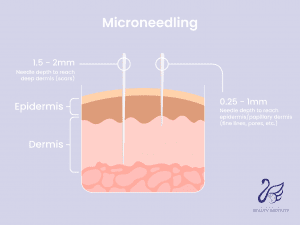Author:
Madeline Lenz ![]()
Those inflicted with acne throughout their lives have lived through the physical and emotional challenges that go hand in hand with the skin condition. Between lesions, redness, inflammation, and more, acne can bring about feelings of embarrassment and lower self-confidence as the skin goes through an internal battle with bacteria. People with acne will often try anything they can to fix their skin, and cosmetic shelves are packed with cleansers, moisturizers, toners and more that claim to be the cure-all.
Unfortunately, even once the acne has been successfully cleared, the trauma may leave behind scarring where the sores once were. The presence of acne scars can bring about new anguish, leaving people insecure once again and desperately searching for a solution.
Because of its depth and often pitted nature, acne scarring can be extremely difficult to eliminate and may last a lifetime if left untreated. Thankfully, technological development has come a long way, and we now have devices that can provide retexturizing benefits to our skin.
Enter microneedling.
WHAT IS MICRONEEDLING?
Microneedling treatments have gained popularity over the years for their ability to reduce the appearance of fine lines and wrinkles and retexturize the skin. After applying a numbing cream, the microneedling device quickly pierces the skin with small, fine needles.
The process of microneedling creates controlled wounds on the skin – prompting the body to begin healing itself. During this healing process, skin is repaired and refreshed and comes back smoother.
The treatment isn’t just limited to the face; microneedling can be done on areas of the body, including thighs, neck, chest, abdomen and more. Needle depth settings are adjustable to suit areas of different skin thicknesses to offer the best results.
Because the skin breaks and the presence of blood is possible during microneedling, it’s essential to have this service performed by a trained aesthetician where proper protocols and safety standards are in place. Doing so will prevent infection and risks and allow for better healing.
HOW MICRONEEDLING WORKS FOR ACNE SCARS
When treating acne scars, products and topicals alone will not do enough to make profound improvements in the skin. Using a microneedling device will encourage the body to take action from within. As the needles puncture the skin and prompt the body’s wound-healing response, collagen production is triggered. This newly created collagen will cause the skin to look plumper, thus “filling” in the acne scar. Due to the plumping effect, microneedling is most effective on scars that are indented/recessed as opposed to raised scars.
Needle depths of 1.5mm – 2mm are ideal for acne scar treatment, depending on the thickness of the skin. Because of the punctures made, the skin will be better able to absorb the skincare products and treatments that follow, boosting their efficacy and desired results.
It’s important to note that while microneedling is effective in treating scars caused by acne, treating skin with active acne is a contraindication, as it can spread bacteria, leading to a greater risk of infection.
HOW MANY MICRONEEDLING SESSIONS DO YOU NEED FOR ACNE SCARS?
For effective acne scar reduction, clients should undergo treatment every 4 – 6 weeks, and microneedling treatment plans may involve as many as 6 – 8 sessions. Clients need to maintain realistic expectations throughout the course of their treatment plan. While an improvement in texture and a reduction of scars will be seen, the total and complete removal of acne scars is unlikely – especially when dealing with particularly deep or extensive scarring.
Combining microneedling alongside a good skincare routine will be the best way to treat acne scars. Skincare products that boast retexturizing and exfoliation benefits may not solve scarring on their own, but when applied routinely between microneedling appointments, they are a great addition. Chemical peels and microdermabrasion treatments can also be incorporated into the client’s treatment plan schedule to help with the textural concerns of acne scarring.
We are fortunate that we can utilize modern technology to reduce the effects of acne scarring on the skin significantly. These skin improvements will not only improve the skin’s appearance but will boost the client’s self-confidence. The retexturizing and collagen stimulation that results from microneedling makes it an outstanding service in a clinical setting. Clients will find themselves interested in its capability of treating acne scarring alongside other skin concerns.
WHERE CAN I DO A MICRONEEDLING COURSE AND CERTIFICATION?
International Beauty Institute offers an online microneedling course!

